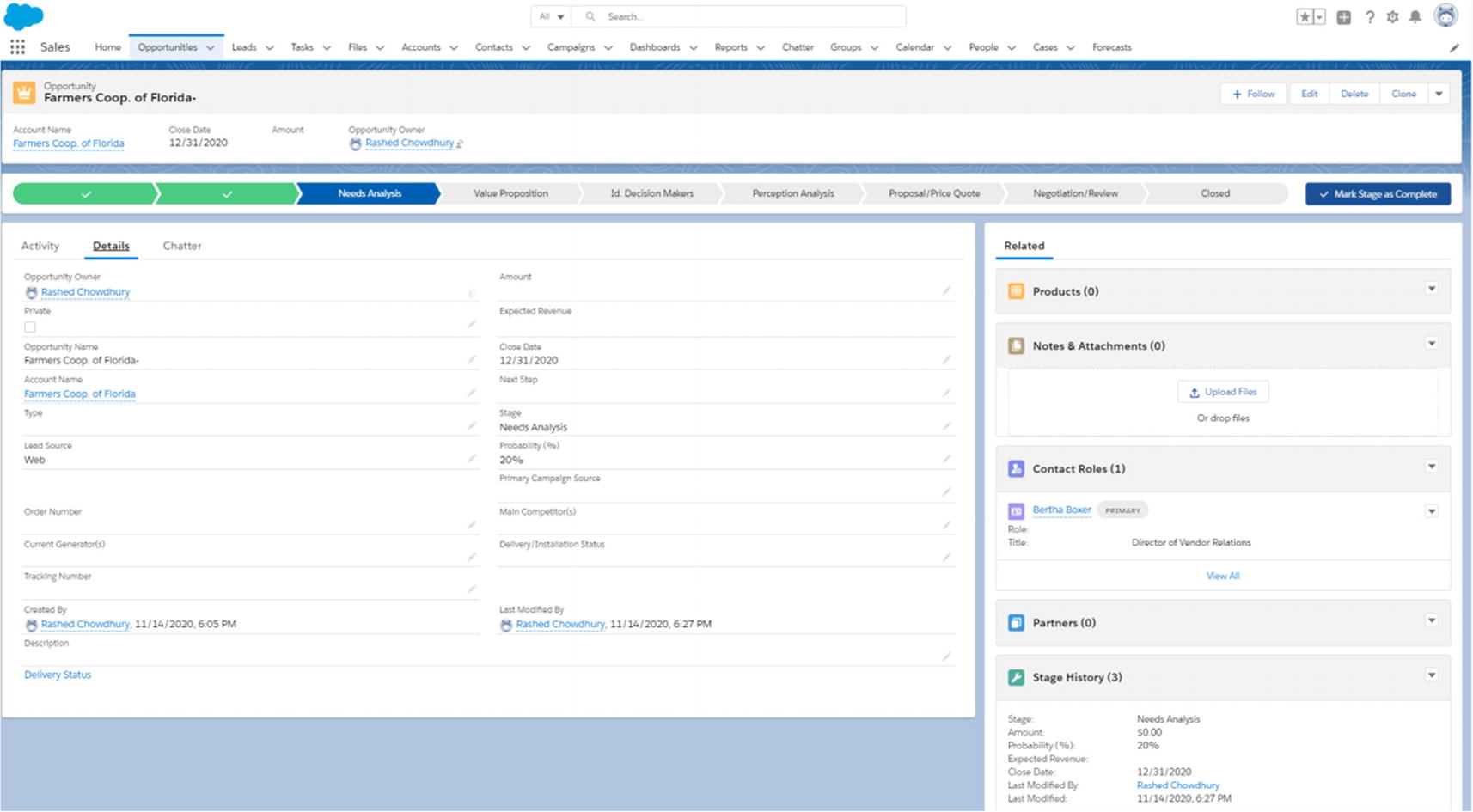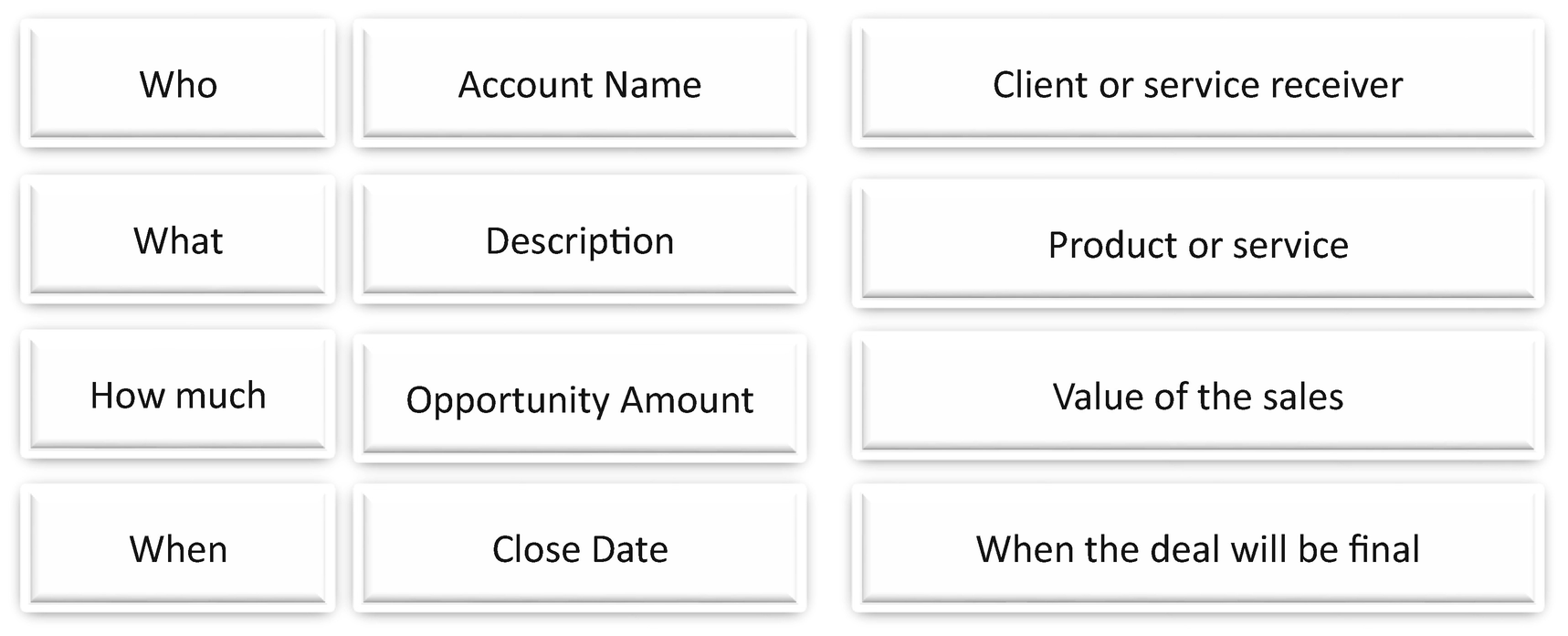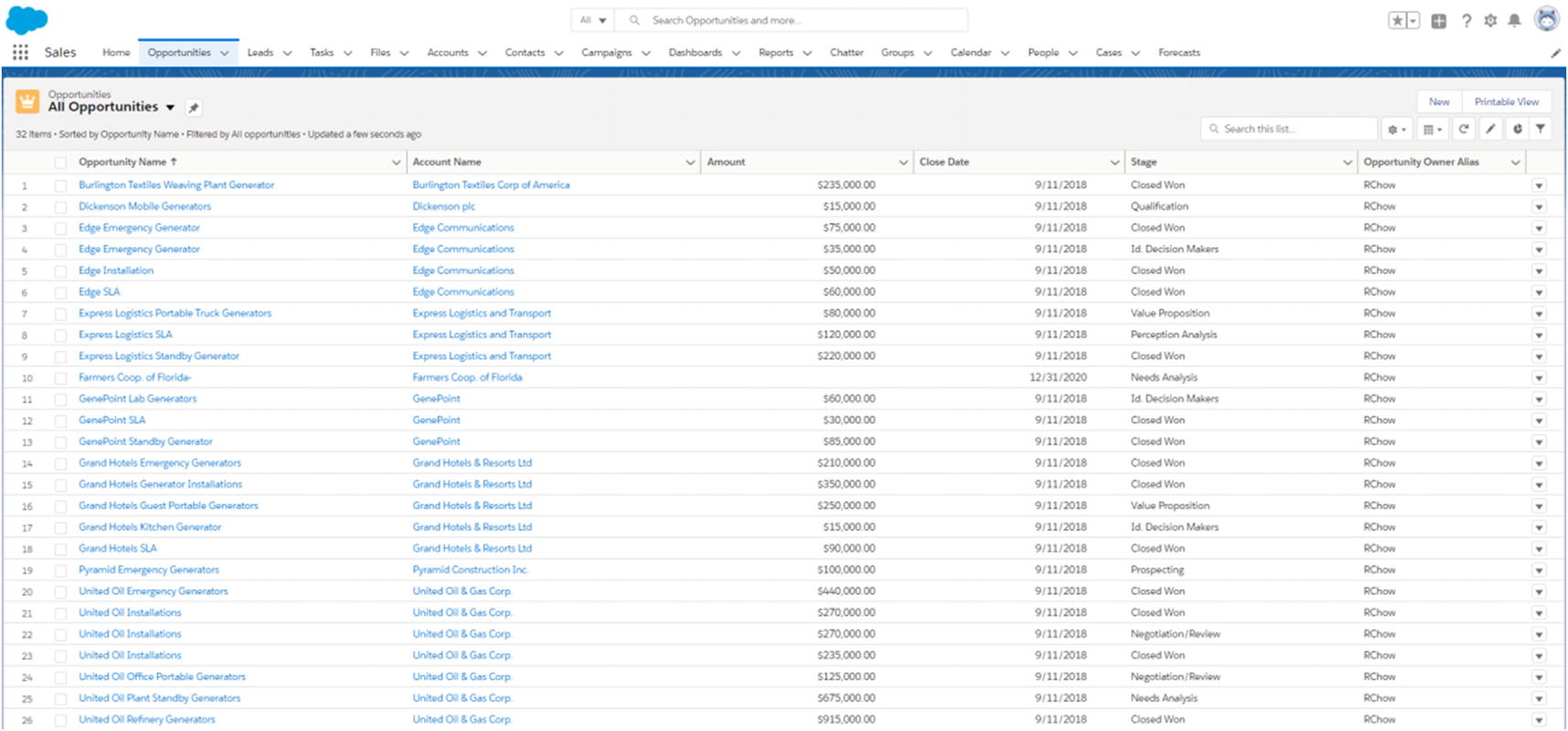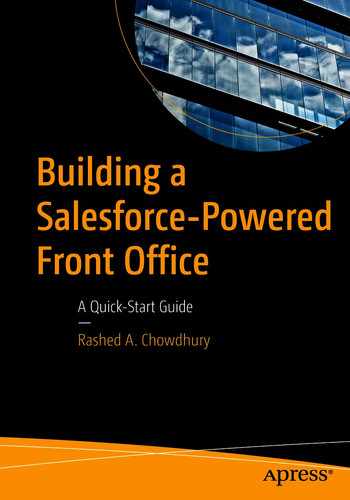In the previous chapter, we had an overview of Leads, the Lead process, how to convert them to create an account, contact, and opportunity. We also covered Lead stages, how to qualify a Lead, and what action to take during each Lead stage. The following topics will be covered in this chapter:
Opportunity definition
Building an opportunity pipeline
Sales stages
Sales stage example
Challenges and trends
Leverage technology
What Is an Opportunity?
Within Salesforce, an Opportunity is an object representing a business transaction (or potential transaction). It is a business deal that is in progress. An Opportunity is automatically created when a Lead is converted to an Account. It has fields for data such as a closing date, projected revenue, or competitors.
Salesforce comes standard with two different types of Opportunities. These types, which are fields a user can set for each Opportunity, are new business and existing business.
A new business is an opportunity (See Figure 3-1) for a company with which you have not yet done business. An existing business is one with which you have already done business, but you are selling them something different this time. Setting an opportunity’s type is useful to categorize opportunities and see how much business is done with new clients vs. existing ones.

Record detail of an opportunity in Salesforce
Custom types can also be created by the user, which is useful for categorizing opportunities according to a company’s needs. Once a type is designed, it will show up in the picklist for the type field of an opportunity. Being able to tailor Salesforce to fit your company with all the features you need to run your business is one of its major strengths.
An Opportunity object is a management aid to nurture and align accounts. Opportunities are tracked in detail in stages. This module helps manage the funnel effectively as well as manage all related tasks and activities for an opportunity, making this an effective single window for opportunity management. A 360-degree view of the opportunity is maintained as the application provides for maintaining all relevant information including products and competitive threats. You navigate the opportunity page to browse and update existing opportunities as well as create new ones.
Standard Opportunity Record
Account name: The name of the account is the legal name of the entity. The account name is the entity that is paying the invoice to you.
Close date: The close date is when the negotiation of a new opportunity is expected to be finalized or an existing business opportunity to be renewed. The date the opportunity is expected to close or the actual date the business was closed.
Amount: The value of the opportunity over some time (12 months, 24 months, etc.). This is calculated based on the product information related to this opportunity.
Opportunity owner: The person who owns the opportunity within the selling organization is the opportunity owner.
Opportunity name: Describe the products or services you are selling in this opportunity. Following a naming convention is a good practice, especially if you have a large organization. The name of the account concatenated with the product or service name and annual term tied to it could become a naming convention, Account name + Product/Service + Annual period (yy-yy).
Stage: The Opportunity Stages are the typical categorization of how an Opportunity – New, Enhanced, and Existing – moves from potential business through closing. A sales stage is one of a series of measurable steps in the sales process – the status of the opportunity in the selling cycle.
Type: The Opportunity type can be New or Enhanced business (new revenue), Renewal or Existing business (recurring revenue), or Marketed Renewal (at recurring risk revenue).
- Probability: Your best estimate of the company successfully closing this sale. The percentage is automatically entered when you select the stage, but you can override the percentage. Use the following to help you estimate:
20%: Long shot.
50%: One in two possibilities.
75%: One in two possibilities with positive buy signals.
90%: Vendor choice through verbal commitment.
Update this percentage as the selling cycle progresses.
A brief description of the specifics of what the opportunity is and the stakeholders involved (imagine you were being asked to explain what the opportunity is) – a couple of lines is sufficient.
A brief explanation of how you have calculated the opportunity value should be part of the opportunity description.
Adding Product to Opportunity

Add products to an opportunity

Editing selected products

Opportunity details with newly added product
From the best practices and user adoption perspective, you want to make sure not to bog down the system with too many custom fields and complex opportunity management process because you will have to make sure that the users are using Salesforce and not make it overly complicated.
Creating a New Opportunity

Minimum data point of an opportunity
If a client is seeking to appoint both liability and property loss adjusters and you know that the client will be awarded the combined business, you will be awarded either both lines of business or neither, and you should create one opportunity.
If a client is seeking to appoint both liability and property loss adjusters but will be making their decision on each line of business, you may win the property but not the liability, then each line of business should be treated as a separate opportunity. This is also the case for where you are creating renewal business opportunities.
Opportunity Organization
Now, let’s discuss the opportunity organization.
Calculating an Annual Opportunity Amount
The amount should always be entered into Salesforce in US dollars.
This figure should not be calculated on the amount of revenue expected between the close date and the end of the financial/calendar year. This figure should exclude applicable local taxes.
It is recognized that there are “ramp-up periods” when setting up accounts. The annual opportunity should be based on 12 months of revenue once the program is fully implemented.
The annual opportunity amount should be reviewed regularly when the opportunity is in the pipeline and when it is won or a renewal opportunity to ensure it reflects reality as closely as possible.
Types of Opportunity
- New customer
New business: This should be selected when the opportunity is for a completely new client which you do not do any business with or a new line of business for an existing client (cross-selling).
- Existing customer
- Upgrade: This field is equivalent to upsell and should be selected for a client you already do business with where you are:
We are increasing product volumes.
We are adding additional territories to programs.
Replacement
Downgrade
Stale Opportunity
Any new business opportunity which is stale by more than 30 days should not be included in your new business pipeline at a global level.
Stale renewal business opportunities should be included in your reporting.
Building a Business Pipeline
Sales Pipeline should represent all open opportunities, both new and renewal, where you are yet to receive a yes/no decision from the prospect/client.
When a new/enhanced business opportunity enters the business, the first action should be to create an opportunity in Salesforce to reflect it. Once an opportunity has been entered into Salesforce, the system will automatically include it in the relevant pipeline.
The user should ensure that the percentage probability of the opportunity renewing in the following year is reviewed once the opportunity has been renewed.
Where you enter into a multiyear contract, the user should ensure that ONLY the next open year of the contract is in the pipeline, not all years in the contract. This is because there is still a chance that you could lose the business over the term of the contract.
- Where an enhanced business win is the upsell of existing product lines, you should merge the revenue of the improved business win into a renewal opportunity for the renewal.
For example, if we win the enhanced business of an extra $1m on an existing account, it should be recorded as an enhanced business win. Instead of renewing this once it is won, you should add the additional revenue from the enhanced win to the renewal opportunity for the existing renewal opportunity.
Year 1: Renewal business for RSA subsidence = $3m and enhanced RSA subsidence win = $1m
Year 2: Renewal business for RSA subsidence = $4m
Opportunity Qualification Questionnaire
Is the key to buying influencers in growth or trouble mode?
Are there proven coaches?
Do we have a clearly defined economic buyer and know the mode?
Can we keep ourselves out of vendor jail?
Is the financial framework acceptable to us?
Is the revenue potential worth the effort?
Does the opportunity fit?
Does the opportunity have a transparent process and time scale?
Is there an opportunity to increase revenue through the provision of additional services?
Does our solution align with the client/prospect strategic plan?
Building an Opportunity Pipeline
An opportunity pipeline (See Figure 3-6) represents open opportunities, including new and renewal businesses. An open opportunity is one where a yes or no decision has not yet been made by the prospect or client. An opportunity pipeline can be measured by the financial year and gross. When measured by the financial year, all opportunities are grouped by close date for a specified year. When calculating by gross, all open opportunities are included.

List of opportunities in opportunity object home screen
When a renewed business opportunity has been won, it should be entered as a Renew Opportunity at the top of the opportunity’s page. This creates a renewal opportunity for the same date but for the following year and will appear in pipeline reports. If an opportunity has been lost, the user should not renew it in Salesforce.
Sales Stages
As an opportunity progresses through the sales pipeline, it will go through several sales stages. Some typical primary stages you may find in Salesforce are Prospecting, Qualification, Need Analysis, Value Proposition, ID Decision Makes, Perception Analysis, Proposal Price/Quote, Negotiation, Closing, Closed Won, and Closed Lost.
The % probability is multiplied by the annual opportunity amount to calculate the expected revenue. For example, $100,000 at 10% would have an expected revenue of $10,000. Through utilizing this across all of our opportunities, we can use the balance of probabilities to gain an understanding of the dollar value of what we can expect to win.
Globally, typical pipeline reports both on the annual opportunity amount and on the expected revenue. For example, if there are ten opportunities with a yearly opportunity amount of $100,000 and all have a 10% probability, then the company’s annual opportunity pipeline will show as $1,000,000 with an expected revenue of $100,000.
It is paramount that users regularly, at least once per month, review the sales stage of their opportunities and % confidence rating of their opportunities and amend so that our reporting is as accurate as possible. For example, create a task with a due date and follow up. Call the prospect and log the call. Create an event (meeting) with the prospect and capture the meeting itself and the outcome, and create a follow-up task, including notes and attachments.
In the Prospecting stage , your business is still reaching out to the potential customer for the first time, done in hopes of establishing a relationship and eventually creating a sale. It is usually the first step in the sales pipeline.
The Developing stage comes directly after Prospecting. After you have first contacted a prospect, you continue to communicate with them and get closer to a sale. Hopefully, this stage will lead to the Negotiation stage, where your business and the prospect negotiate on the price for the products/services rendered.
The final two stages are Closed Won and Closed Lost. A sale would be Closed Won if the sale were successful following negotiations. If it was not successful and business between your company and the prospect will not be happening, the sale is Closed Lost.
Each of these stages is assigned probabilities in Salesforce. The stages specifically used and their probabilities are up to the salesperson and can be custom created and assigned. The probability represents the likelihood that the opportunity will end up as a sale by the end of the sales pipeline. It generally trends upward throughout the stages, with an opportunity in the Prospecting stage having the lowest probability, while an opportunity in the Negotiating stage is having the highest probability of becoming a closed sale.
Users should ensure they keep Salesforce up to date with the latest information on opportunities. They should be created where necessary and kept current on what stage they are in and other information relevant to the sale. This is important to ensure accurate reporting within Salesforce .
Sales Stage Example with Exit Criteria
Entry and exit criteria in opportunity stages
Stage | Probability (%) | Entrance Criteria | Exit Criteria | Who’s Involved? |
|---|---|---|---|---|
Target/Prospect | 10% | • Converted lead | • First meeting held • Presented product | Sales Pre-sales |
Qualify | 20% | • First meeting held • List of requirements generated | • Reviewed requirements with the prospect • Identified decision-makers at the prospect • Identified how to meet requirements • Entered in the estimated amount • Entered in an estimated close date | Sales Pre-sales |
Requirements | 40% | • Requirements and solution determined | • Three proposals are created • Proposals are approved by Ops • Manager (VP 20% discount) • The updated amount and close date • Scheduled meeting to review the proposal with decision-makers | Sales Pre-sales Sales Ops Sales Manager Sales VP |
Presentation | 60% | • Scheduled meeting | • Presented all three options • Prospect verbally commits to a deal or signs a letter of intent | Sales Pre-sales |
Acquisition | 80% | • Prospect agrees to the proposal | • The contract is drawn up (by legal if nonstandard) • Prospect signed contract • Prospect issues PO | Legal Sales Ops Sales |
Closing | 90% | • PO is approved | • PO is set up for invoicing • Product is shipped | Sales Ops |
Closed Won | 100% | • Product is shipped | Sales Ops | |
Closed Lost | 0% | • Prospect ends sales cycle | Sales Ops Pre-sales Consultants |
The entrance criteria for a given stage are specific events that have occurred for a prospect to be considered as a part of that stage. The exit criteria are the last events that must occur for the prospect to move onto the next stage. Oftentimes, you will see the exit criteria are the entrance criteria for the following stage.

Opportunity stages
Closed Won and Closed Lost are also given one additional stage here – Closing. The closing comes right before Closed Won. The prospect has already signed the contract, and the order has been approved, but sometimes things may come up, and the contract does not always progress to Closed Won. Closed Won is when the product has been shipped, and the sale has been 100% made. The Closed Lost stage may occur at any stage, simply when the prospect has ended the sales cycle and has no interest in continuing.
Summary
In this chapter, we discussed the concept of opportunity, opportunity pipeline management, sales stages, entry criteria, and exit criteria of the opportunity stages. We also covered the definition of opportunity from Salesforce’s perspective, building an opportunity pipeline, what to do during sales stages, examples of sales stages, challenges and trends of modern sales, and how to leverage technology to address them. In the next chapter, we will review what the definition of the customer is, how Salesforce defines account, personal account, and consideration for measuring customer satisfaction survey.
